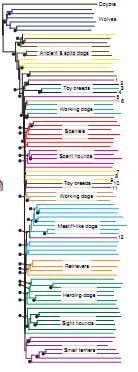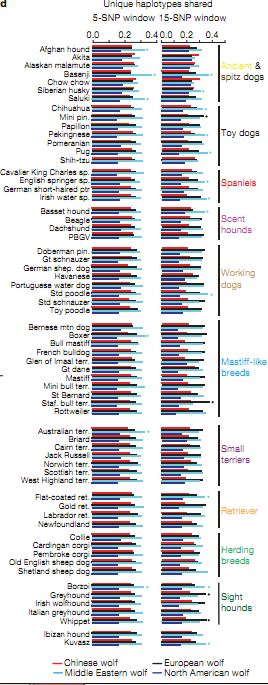A Genomic Look at Dog Domestication
Genome-wide SNP and haplotype analyses reveal a rich history underlying dog domestication
The authors used genomic tools to build a history of dog domestication all the way from wolves to Victorian Age breeding to today. To do this they collected DNA from 912 dogs from 85 breeds, 225 grey wolves from 11 different geographically distinct regions, 60 coyotes, and more from other wolf, dog, or wolf-dog species. This large amount of DNA was typed for 48,000 single nucleotide polymorphisms (SNPs) that had been found in the previously sequenced boxer genome. Many of these SNPs come in haplotypes, or linked groups on a chromosome that are often passed on together. By comparing the number of these haplotypes the various breeds and wolves had, the authors could develop a picture of the evolutionary relationship between not only the wolves and dogs, but also between the breeds within a specific function group such as herding dogs (Figure 1).

Figure 1. Phylogenetic Tree built using the number and type of haplotypes shared between dog breed and wolf populations (vonHoldt et al. 2010) (Permission Pending)
The authors used genomic tools to build a history of dog domestication all the way from wolves to Victorian Age breeding to today. To do this they collected DNA from 912 dogs from 85 breeds, 225 grey wolves from 11 different geographically distinct regions, 60 coyotes, and more from other wolf, dog, or wolf-dog species. This large amount of DNA was typed for 48,000 single nucleotide polymorphisms (SNPs) that had been found in the previously sequenced boxer genome. Many of these SNPs come in haplotypes, or linked groups on a chromosome that are often passed on together. By comparing the number of these haplotypes the various breeds and wolves had, the authors could develop a picture of the evolutionary relationship between not only the wolves and dogs, but also between the breeds within a specific function group such as herding dogs (Figure 1).
Figure 1. Phylogenetic Tree built using the number and type of haplotypes shared between dog breed and wolf populations (vonHoldt et al. 2010) (Permission Pending)
The
comparisons of haplotype possession between dog breeds and wolves, and
figures such as the phylogenetic tree of Figure 1, supported previous
historical data about the order of development of various dog breeds,
as demonstrated by the fact that some breeds have already been
designated "ancient breeds". Their data both confirmed and
fleshed out previous ideas on the development of various dog breeds,
but they also wanted to test the belief that dogs were originally
domesticated in Eastern Asia. This is why they had gathered DNA
from grey wolves of 11 different regions of the world. All the
tested dog breeds had how many haplotypes they possessed that were also
found in wolves from from 4 different parts of the world: China,
Europe, the Middle East, and North America (which served as a negative
control since it is known the dogs did not originate there) (Figure 2).
Almost all breeds shared a higher percentage of haplotypes with
the
Middle Eastern wolf population, leading the authors to conclude that
the original domesticated dogs came from wolf populations of the Middle
East.

Figure 2. The fraction of haplotypes found in a region-specific population of wolf that is also found in a breed of dog. (vonHoldt et al. 2010) (Permission Pending)
Figure 2. The fraction of haplotypes found in a region-specific population of wolf that is also found in a breed of dog. (vonHoldt et al. 2010) (Permission Pending)
Using
advanced statistical tools to compare the SNPs conserved in dogs but
not wolves, the researchers also found a few genes they believe to be
candidates to be genes positively selected for when dogs were
domesticated. Two genes near regions that scored high under this
analysis have versions in humans and mice that have been found to be
related to memory and becoming sensitive to behaviors, both of which
would have been important in order fo humans and proto-dogs to have a
symbiotic relationship. Another high scoring SNP was near a gene
responsible for a disorder of exceptional friendliness in humans.
Given that wolves are carnivorous, it is likely that friendliness
was an important feature for any domesticated wolves.
Popular Media Coverage
Dog is said to be man's best friend and the popular media assumed, likely correctly, that many have wondered and would be interested in where their dog has come from evolutionarily. To match this area of interest, The New York Times article on the paper focused on the authors' assertion that dogs were first domesticated in the Middle East, to the virtual exclusion of anything else put forth by the authors, including the specifics of the methods used to reach that conclusion. The extent of the description of the methods is the researchers scanned "for similar runs of DNA" and that the authors made use of SNPs. Admittedly The New York Times is writing for people with a very limited science background, but they fail to even say what the abbreviation SNP stands for.
The relationship between the different dog breeds is mentioned only in passing, composing a single paragraph in which it is said that different function groups were found grouped together, and that this surprised one of the authors, who offers a quote. A part which half the figures in the original paper are designed to support is confined to a two sentence paragraph.
The popular source does a good job of providing context for the feature they decided to concentrate on. They explain how this new data fits in with other data from other studies and fields including archeology, briefly explain the old, contradicted explanation for where dogs were domesticated and even get a quote from the purporter of that theory, and get reactions from other experts in the field. Thus the article covers its limited scope very well, but would leave the reader mostly oblivious of other results of the study and the methods of the study in general.
Popular Media Coverage
Dog is said to be man's best friend and the popular media assumed, likely correctly, that many have wondered and would be interested in where their dog has come from evolutionarily. To match this area of interest, The New York Times article on the paper focused on the authors' assertion that dogs were first domesticated in the Middle East, to the virtual exclusion of anything else put forth by the authors, including the specifics of the methods used to reach that conclusion. The extent of the description of the methods is the researchers scanned "for similar runs of DNA" and that the authors made use of SNPs. Admittedly The New York Times is writing for people with a very limited science background, but they fail to even say what the abbreviation SNP stands for.
The relationship between the different dog breeds is mentioned only in passing, composing a single paragraph in which it is said that different function groups were found grouped together, and that this surprised one of the authors, who offers a quote. A part which half the figures in the original paper are designed to support is confined to a two sentence paragraph.
The popular source does a good job of providing context for the feature they decided to concentrate on. They explain how this new data fits in with other data from other studies and fields including archeology, briefly explain the old, contradicted explanation for where dogs were domesticated and even get a quote from the purporter of that theory, and get reactions from other experts in the field. Thus the article covers its limited scope very well, but would leave the reader mostly oblivious of other results of the study and the methods of the study in general.
VonHoldt, Bridgett M. "Genome-wide SNP and Haplotype Analyses Reveal a Rich History Underlying Dog Domestication." Nature 464 (2010): 898-902. ISI Web of Knowledge.
Web. 27 Jan. 2011.
<http://http://apps.isiknowledge.com/full_record.do?product=UA&search_mode=GeneralSearch&qid=1&SID=4ACeLDcghdK6aAFbedK&page=1&doc=4&colname=WOS>.
Wade, Nicholas. "New Finding Puts Origins of Dogs in Middle East." The New York Times 18
Mar. 2010: 6. 17 Mar. 2010. Web. 27 Jan. 2011.
<http://www.nytimes.com/2010/03/18/science/18dogs.html?pagewanted=1&_r=1&ref=science>.